
And So Much More
The dive UK blogs you have read are summaries of our bigger trips but there were so many more places we found which are worth a mention.
Bear in mind we were in Salford which is the heart of the old mill trade, a city which conjours up grey buildings and tall chimneys belching smog over the oppressed, colourless and exhausted workers (think Lowry and his cityscapes). Despite this we had access to a plethora of really unique places, rivers, lakes, frozen estuaries, quarries and rocky coastline, just up the road.
I will give you a quick whizz through some of our favourites just to complete the picture and to prove that when you meet us and we tell you diving UK is amazing, we are really telling the truth. The sad fact is most UK divers we meet in SA don't even dive their own coastline, preferring the balmy water of the tropics.
Shhh its a well kept secret.





St Abbs 1983
St Abbs is a small village on the South East coast of Scotland, an area of Scotland known as the Scottish Borders. It a fishing village with a small fleet of lobster boats, but it is also the oldest voluntary marine reserve in the UK, having been established in 1984. There is now a state of the art marine research station there.
St Abbs Marine Station https://www.youtube.com/watch?v=Whv_UmwF1mU

St Abbs Harbour
It is a popular scuba diving destination because of the clarity of the water which contrasts with the more silty conditions to the north and to the south. Warm and cold currents meet here, which may be the explanation for the clear conditions, and contributes to an extended range of marine life. Shore dives are easily accessible from the harbour wall to depths of up to 15m and boat dives can be arranged with the local fishermen.
A more recent claim to fame is that it was the site of New Asgard in the filming of the last Avengers film, Endgame. Apparently this has led to a dramatic increase in visitors. Who knew. We were happy when it was just a beautiful village by the sea!
Our first trip here occurred just after Dudleys best friend from SA arrived to stay with us for a visit. John had never scuba dived but, to be fair, was a pretty athletic guy with lots of snorkelling, cray fishing and sailing experience. We decided we could not leave him behind and he wanted to dive so, for our sins, we told the club he had scuba qualifications and spent the 4 hour drive there from Manchester teaching him the A-Z of scuba. We roped in our mate Derek Gould, a radiologist, and took it in turns to drive, lecture and snooze.
He must have been a quick learner because no one ever doubted him and we did not kill him. This is one of our memories which makes me wince a bit, now that I view the world through a slightly more responsible prism, but in those days….Ah well. His dive experiences did not end there as he stayed with us for 6 months and was dragged all over the place, boat and wreck diving with the best of us.

The intrepid John, the ultmate self taught diver!

The dive sites out of the harbour
St Abbs Harbour
On our first evening we arrived quite late but could not wait to get in the water and jumped in for a quick snorkel around the harbour wall to Big Carr. Beautiful clean water and so much life. Usually in UK diving we are happy with 5 m visibility but here we had 10m and more. Almost unheard of and we were ecstatic. At 7C the temperature was chilly but it is the North Sea after all.
Cathedral Rock
This is a famous dive site in St Abbs, also accessible from the shore but a hard swim. It is a couple of arches covered in sea life. To be honest, despite a couple of attempts and lots of rather inept compass navigation, I am not sure we actually found it but all the topography was beautiful with rocks and gully’s and abundant sea life.
Pettico Wick Bay and The Peanut Boat
Pettico Wick Bay is in the St Abbs Head National Nature Reserve north of St Abbs. A beautiful bay with a small slip way and a previous salmon fishery. The car park will only take a maximum of 4 cars and you can be assured of a beautiful and peaceful day there if you can secure a spot. We spent the whole day there, snorkelling and diving. The vis was again exceptional, up to 15m Beautiful kelp forests with fish and crustaceans.
We took the tanks out to look for The Peanut Boat, the wreck of a lobster trawler, but all that was left was a steel cylinder. Still the life was worth all the effort.

John doing his homework
Having exhausted our shore diving we roped in a local fisherman, Alastair, and his brother to take us out a bit further afield. We met Alastair for the first time on the quay where Dudley was perched on the harbour wall. The first thing he said to him was ”you’ve got shite on youuurr troousers” in such a broad Scottish accent Dudley was at a loss until we managed to translate in gales of laughter. From there we probably understood about 1 in 4 words out of Alistairs mouth.
He told us that his previous boat had been confiscated because the fishing authorities had boarded it and found 1 salmon scale on the deck. It seemed a bit harsh and reinforced the rather feudal laws still firmly in place. The only people allowed to catch salmon were the landed gentry with estates. Not the hard working locals. Most unfair although I have no doubt that Alastair was up to his eyeballs in illegal salmon fishing, the ill gotten gains of which had purchased him a new boat!
Our last dive was on The Well, below cliffs on which a ruined castle stands, where Mary, Queen of Scots, was supposed to have stayed. The Well served the castle before the cliffs eroded and collapsed the well causing the fresh and salt waters to mix. Again remarkable topography of folded rocks and sea life. Lots of anemones, crabs and lobsters. Really this is a little paradise on earth.
He dropped us north against the cliffs in Harelaw cove because of the winds blowing out the harbour side. Again we were awestruck by the sea life and natural beauty. In Hodge Close we found beautiful kelp forests with gullies as we drifted effortlessly with the current. We finally identified lump suckers, weird little fish whose front fins are modified as suckers to cling onto rocks. They are usually seen further North but St Abbs holds many creatures at the end of their normal ranges because of the unusual sea conditions.
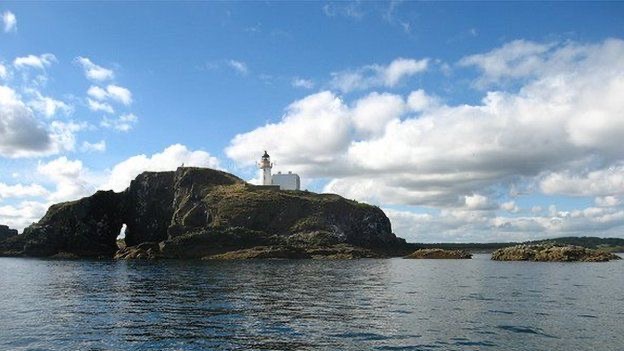
St Abbs Head
I won’t lie, most of our UK diving was driven by wrecks and salvage, probably because visibility and conditions did not allow us to see or appreciate the whole range of marine biology on offer, but St Abbs was definitely one for the marine life. It is renowned for lots of other wonders of nature and birds but in those days our eyes were firmly down to the water and not up in the skies.
Millport and the River Clyde 1982/83

The Intrepid Researchers!
The town of Millport is on the Island of Cumbrae in the Firth of Clyde in Scotland. The Clyde estuary has long been considered of marine interest, in 1884 a floating laboratory was established there and Millport Marine Biological Station was opened in 1897, run by the University of London. It had an active academic and research curriculum and in the university holidays the halls of residence were available for rental and divers were able to book in and use the diving facilities. A long pier ran out into the estuary from a wooden building and the end of the pier was equipped with hot showers, a dive chamber and a lifeboat station.
I am not sure how we found out about this gem, I think it was when we went to do an adult marine biology night class at Manchester University. We spent 2 evenings a week dissecting cockles and periwinkles in the science labs. My dive notes says we were there to collect specimens so it looks like we signed up to be amateur researchers. So, in Nov 1982, Dudley and I took the trip to Glasgow and the ferry across the Clyde to Millport. There was snow on the mountains ringing the horizon which should have prepared us for the water temperature (1C, the lowest I ever recorded!). It made the hot showers on the pier essential to life and not a luxury.

Ferry across the Clyde to Millport
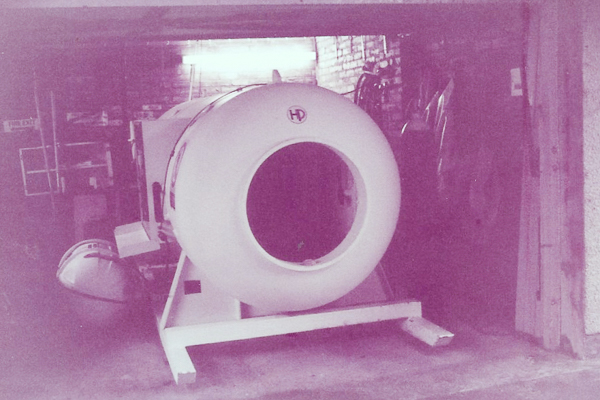
Decompression chamber in a shed on the end of the pier. We did our first chamber dive here.
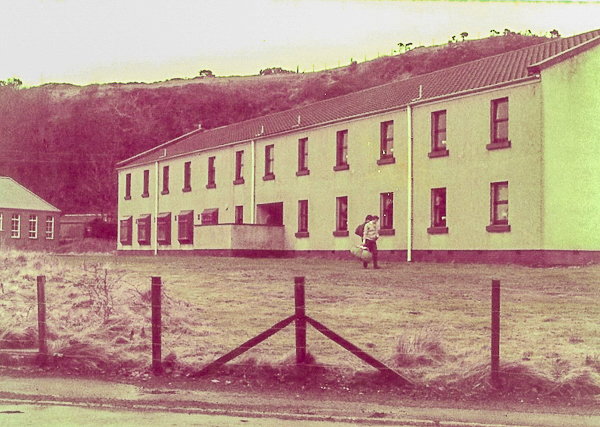
Our home for 3 days, the students hall of residence.
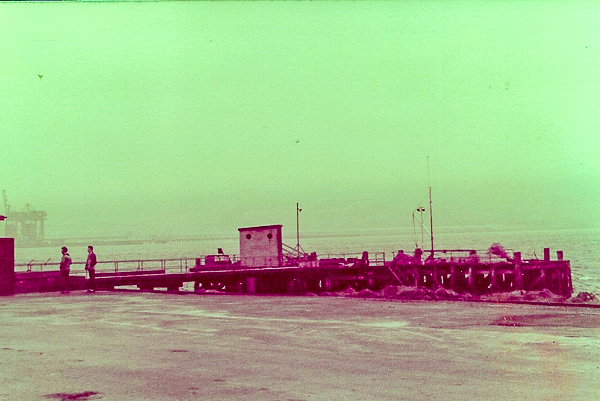

The Pier
The first dives were taken straight from the pier, essentially you geared up in the wooden hut, walked down the pier and jumped in. We did a few of these dives, freezing cold, 5C max, but with good visibility and lots of life under and around the pier.
Several night dives were done here, the bottom alive with crustaceans and star fish. To be fair, day or night, the temperature was about the same but the hot shower was a life saver.
I will never forget another couple we met on the trip. Both elderly pensioners in their 70s who had just learnt to dive. They came out of the change rooms propping each other up and they hobbled down the pier doubled up under the weight of the gear, and disappeared over the edge while we watched in horror. To be honest we wondered if it was a suicide pact but , as unexpected as it was, they climbed out again at the end of the dive, still looking close to death, but gamely enthusiastic. How to age gracefully. They became our role models.

The coastline
Ammo barge
The Ammo barge was an old shipwreck lying off the lighthouse in 15 m of water. It was in good condition but all the non ferrous had been removed as had the old ammo. Still we were there to observe the marine life so there.
Flying Catalina
In March of 1983 we returned to Millport to explore some more. The famous wreck here is a Catalina Flying Boat, an amphibious aircraft that crashed and sank in 1943. The plane was doing practice water landings and a miscalculation by the pilot saw the plane crash into the sea. The pilot died but the crew were rescued.
This is the first underwater plane wreck we had seen, so quite exciting. Lying between 15 and 20m, it is renowned for an unusually large conga eel living in the cross strut of the wings but we did not see it. The wings and back of the plane were largely in tact with a covering of anemones and soft coral.
On this trip the water temperature had dropped to 1-2C and yes there was still snow on the mountains. Brain freeze. Note to self, try for the summer University holidays next time.
The Isle of Man 1983


Views of the Isle of Man, famous for the motor racing and a favourite amongst the yachties. Those yachties know their tax havens!
The Salford BSAC arranged another outing to dive the Isle of Man over a long weekend. We dived off the Harry Slater, a 55 ft modified pilot boat which sailed across to Holyhead in Anglesey to pick us up. The sea was so flat it was like a mirror and believe me this does not happen on the Irish Sea very often. I have done the ferry crossing to the Isle of Man before with every passenger heaving over the side. But we sailed on glass in sunny weather and a gentle breeze. Dudley still managed to lose his fishing rod overboard though. I think it was trying to tell us something. Fish are friends, not food.

Enjoying the flat calm crossing
We headed for the south where a small island called the Calf of Man lies.
One of the major features around this area are the vicious tidal currents up to 8 knots so diving requires careful calculation of the tides to determine the time of slack current. Unfortunately for us our skipper had calculated his slack from a Liverpool tide table. Enough said, some of the Isle of Man dives were the fastest drift dives we have ever known. On one occasion we were carried 5 km out to sea in about 20 minutes. But it was exhilarating and beautiful and packed full of sea life. Often we hung with white knuckles onto rocky shelves, our bodies strung out like flags vibrating in the current and watched the world go by.

The Calf of Man, the currents between The Calf and the mainland were particularly vicious

The Harry Slater
WRECK DIVING
Clan Mac Master
We did manage to dive a couple of wrecks. The Clan MacMaster was a 6500 ton freighter that ran aground and knocked down the lighthouse in heavy fog in 1923. She was carrying light and heavy machinery and sewing machines. The crew all escaped to land but by the next day they found most of the cargo had already disappeared. Go the Manx! She slipped off the rocks some days later and the engines lie in 2 m of water and the bottom in 20 m covered with abundant sea life.
The Citrene
This Citrene lies just off the main town of the Isle of Man, Port Erin. Sitting in 15 m this is the wreck of a 1500 ton coaster lost in 1956 when she ran aground, again in fog. She was carrying a cargo of limestone and many crew members were lost. We found lots of brass and non ferrous including a substantial propellor shaft. Lots of fish life including brightly coloured wrasse which would eat urchin from your hand.
It was a magical trip, both for the incredible dives and the unusually benevolent weather. We were blessed.

Kitting up. Dudey moaned because the guys in wetuits had to kit on deck but the drysuit guys got to kit up in the warm dry cabin.
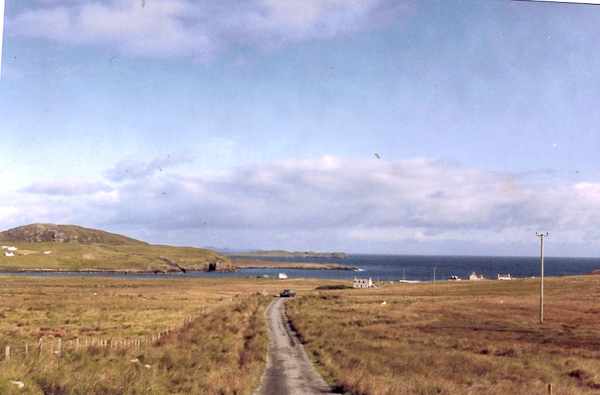
Devon and Cornwall 1983
Not surprisingly the south of the UK is perhaps more popular for diving than our stamping grounds North. It is generally cleaner, warmer and more civilized, so, on a short staycation down to Devon and Cornwall we packed our dive gear and went for a look see.
As we were not planning this as a dive trip it took some time to find an air station, but finally we found one at Looe. The station had pressure tanks and tank fittings and a coin operated system to allow you to put in coins and get out compressed air. Self service. Wow that’s not going to be happening any more I’m thinking. You may as well try and fill it at the air hose of a petrol station.
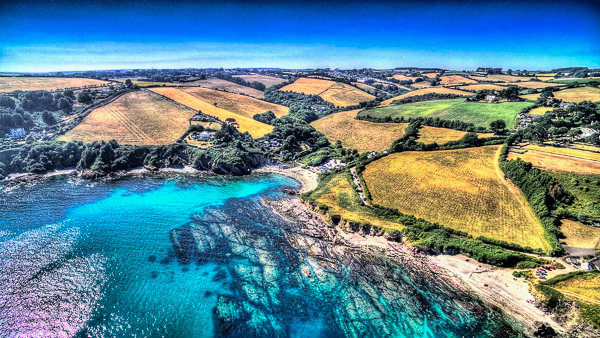
Talland Bay
Talland Bay
We stayed in a camp at Talland Bay and took shore dives into the bay. Reputed to have 3 wrecks in the bay we were keen to explore. The sea was blue and beautiful, good vis, a balmy 12C water temperature and a gently sloping bottom made it all pretty easy. The fish life was excellent, including giant spider crabs. Despite grid searching for 2 hours our intrepid treasure hunters found no wrecks.

Downderry Beach
Downderry and the wreck of The Gypsy
Encouraged by Talland Bay our next outing was at Downderry. This is a very shallow bay and we practically leopard crawled the first 500m. The swell and the kelp made for some serious discomfort. The wreck of the Gypsy lies in 7m of water. She went down in 1901 having lost her bearings en route to Plymouth. Because of hazard the wreck was blown apart by explosives. We found scattered wreckage but nothing recognisable, and the whole trip was exhausting. Still it was a start and the British south coast definitely had potential. Unfortunately our explorations ended there.

Underwater Cornwall
Stoney Cove 1982
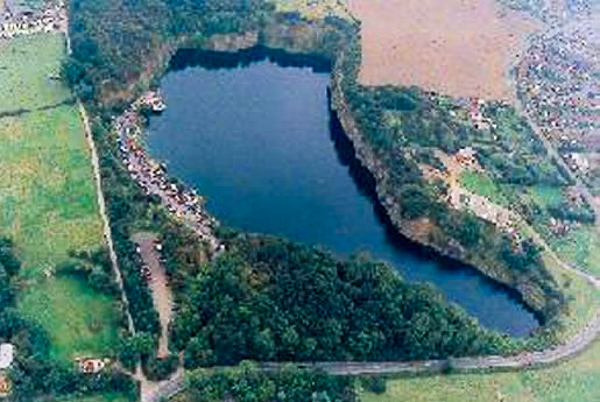
Ariel view of Stoney Cove
Stoney cove is a reservoir between the M1 and M6 just west of Watford Gap and there we travelled for our Deep Water Rescue Course weekend, BSAC style.
Now it has been my observation over the years that the commercial rescue courses have run the course from the sublime to the ridiculous, culminating in the Covid era of virtual buddy breathing and doing a controlled emergency ascent on dry land with sound effects. What’s next? Zoom CPR perhaps. News flash, this is unlikely to equip you for a real emergency rescue. Indeed you may argue nothing prepares you for a real emergency but I can tell you one thing. BSAC took its rescue courses seriously and they were going to give you as near to a real life, or near death, experience as they possibly could, come hell or high water!

A Map of Stoney Cove. It is now the National Dive Centre and over the years various wrecks and artifical reefs have been sunk there for the divers but that was mostly after our time.
We were on a 2 day course. The first day they tied 15kg of lead around our waists and made us swim on the surface between 2 buoys until we drowned. Well not quite but you get the drift. The moral of this test was you cannot swim with weight….ditch your gear. All of it. Even the pretty new expensive stuff. Of course we are always told this but I think you retain a sense that maybe you can decide at the time, maybe you can compromise or save stuff. From that day, when incidentally I nearly drowned and had to be towed in by safety marshals in a state of exhaustion, I have never doubted the truth.
As the candidates were now knackered. We were sent back in to rescue a dummy at 20m with a controlled buoyant ascent in pitch dark. Good job the dummy was already dead. We slept like the dead that night. Ironic really.
Next day was the full Monty, We paired up into buddy pairs and were sent back out in full gear to rescue each other. I got paired with a mountain of a man maybe 120 kg. I was a mere 50kg slip of a girl at this stage. The plan was the victim would “drown” at 20m in the middle of the reservoir and the rescuer must swim from shore, find the diver, do an emergency ascent then tow 150m doing CPR. The CPR was mouth to mouth. The victim blowing a raspberry every time you did not make a seal. As the rescuer you had to fin up out of the water and tilt the victim towards you just to get in a position to make contact. My man mountain was almost impossible for me to move. Tow , breathe, tow, breathe, it was excruciating. I wondered why they had safety divers every 10m until we had to be rescued after about 40m in a state of exhaustion and more raspberries than a Pavlova pudding. What did you learn I was asked? The answer to this, almost rhetorical, question was that a 50kg girl cannot rescue a 120kg man in full gear and we would all die. Yet another harrowing trial by fire reinforcing the fact that ditching gear is the first thing you do. Always. They then went about demonstrating the mouth to snorkel technique and a small chink of light emerged for the survival of my next victim. Pretty straight forward you may say but the training was brutal and incredibly memorable. I would defy a Padi or Naui course to leave that impression.
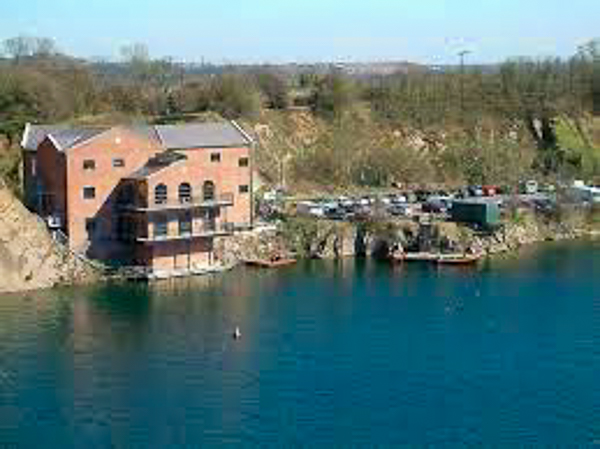
The jetty to the right of the main building were where we attempted to land our victims
The afternoon was spent learning how to log roll people up the side of docks and jetties using a series of ropes and odds and ends scavenged from the side of the water. Knot tying and cooperative rope tricks were pretty neat.
We collapsed in a heap and returned home buggered but informed. In my case that I probably would not successfully rescue anyone by myself but if I wanted to try, ditch gear and use a mouth to snorkel. Never forgotten. If you ever start to drown near us, head for Dudley.